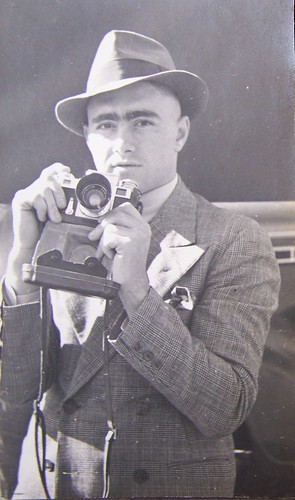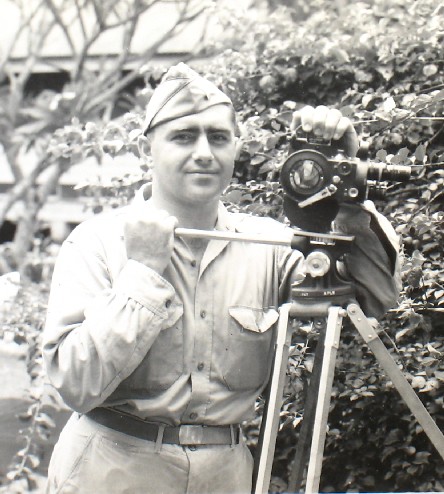 |
| My brother, me, my grandmother and my cousin (Photo taken by my father, developed and printed in his darkroom in the 70s) |
Second Generation Shutterbug
I am a poor excuse for a photographer, even an amateur one. I like to think I have a good eye for spotting a great photograph, I just don't always have the right equipment with me, or remember how to use said photographic equipment to it's fullest potential. I really have no excuse, considering I am a second generation shutterbug. For years, I've heard stories from my dad and uncle about my grandfather's photographic exploits before, during and after WWII. I sent them each an e-mail requesting more detailed information and they gladly provided the following tidbits: My father told me my grandfather, Ralph, became a photographer while attending Leavenworth High School during the 1930s. He also worked and learned from a local Leavenworth camera shop and portrait studio called Star Studio. My uncle added that photography during the 30s was still an arcane, complicated and a very hands-on hobby/profession.
My father told me my grandfather, Ralph, became a photographer while attending Leavenworth High School during the 1930s. He also worked and learned from a local Leavenworth camera shop and portrait studio called Star Studio. My uncle added that photography during the 30s was still an arcane, complicated and a very hands-on hobby/profession.Even with film purchased from commercial sources, photographic developing and printing (separate processes) involved the precise mixing of chemicals and control of temperature and humidity to develop and fix the image on the film, and to develop and fix the image on the paper. Both processes—plus the actual exposure of the photo-sensitive paper to the projected image from the developed film—required rigorous control of environmental conditions. Ralph took pictures for the Leavenworth High School year book. In 1937, Ralph won statewide (Kansas) honors as the top (or one of the top) science students in public high schools.
Both my dad and uncle confirmed that after graduating, Ralph also worked for the local newspaper, the Leavenworth Times as well as continuing at Star Studio. Some of his work appeared in the paper.
 |
| Ralph Andrea, WWII Army Photographer |
My dad remembered Ralph's equipment best. Ralph had several cameras including a 4x5 Speed Graphic; an Argus C3, an early 35mm; and, he did some early color work during WWII, before the film was available to the public. Ralph held a patent on a modification to the old flash bulb to keep them from going off when in close proximity to radar equipment.
My uncle relates more detailed information regarding Ralph's military service: With the onset of World War Two, Ralph volunteered for duty in the US Army Air Corps, enlisting at Sherman Field on Fort Leavenworth. Because of his experience with highly technical photography, he was elected for further training both as a photographer and as an officer (despite his not having a college education).
 |
| Ralph resting his arm on his Speed Graphic camera |
After World War Two, Ralph earned a bachelor's degree in engineering at the University of Kansas, followed by a master's in photographic engineering at Boston University. His Air Force work included collaboration with General George W. Goddard, the "father" of modern aerial reconnaissance, developing concepts and systems for both air-breathing and satellite reconnaissance.
In his later years with the United States Air Force, Ralph worked at the Defense Intelligence Agency, Headquarters USAF and HQ Air Force Systems Command to identify and procure future reconnaissance systems. During that time, Ralph was involved in the development of computerized systems to record and transmit photographic systems. He retired in 1968, before the advent of micro-computers which revolutionized the capture and processing of images but his work brought the USAF to the cusp of exploiting those digital systems as they developed.
I wish to express my deep gratitude to my father and uncle who provided, at the drop of a hat, the scanned photographs and commentary for this section.
Family Vacation Slideshows
My dad took us (mom, my brother and I) all over the continental United States, following his brother's military migrations and also to visit my mother's relatives in Montana and the Pacific Northwest. Consequently, before I had graduated from high school, I'd been to all but three of the lower 48 states and at least two Canadian provinces. We visited nearly every National Park, massive hydroelectric dams, a few nuclear power plants, a meteor crater, caves, mountains, deserts, a rain forest and historical sites from coast to coast. Once we returned home, and the slides were returned from the developer, we'd gather with local friends and family for a re-cap slideshow of our latest vacation adventure.Annual Christmas Card Family Photo
 |
| My mom, me, my dad, and my brother (circa Christmas 1974) |
Recording My Own Family
 |
| Rachelle 'climbing the mountain' that was our storm shelter. |
Sunrise, Sunset
 |
| Sunrise (Mar 2011) |
Astrophotography - My Final Frontier
 |
| Crescent Moon (Apr 2011) |
No comments:
Post a Comment